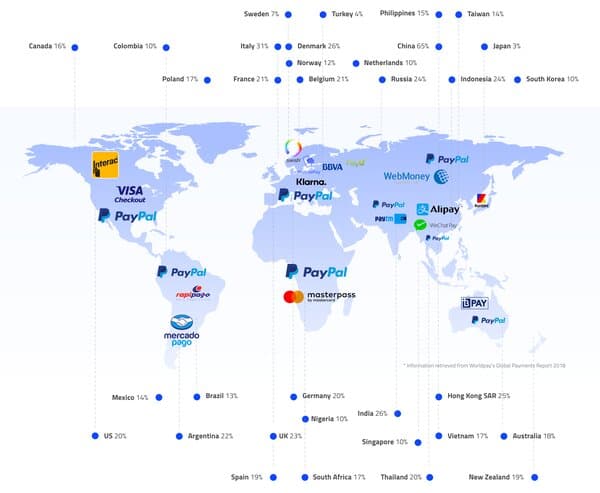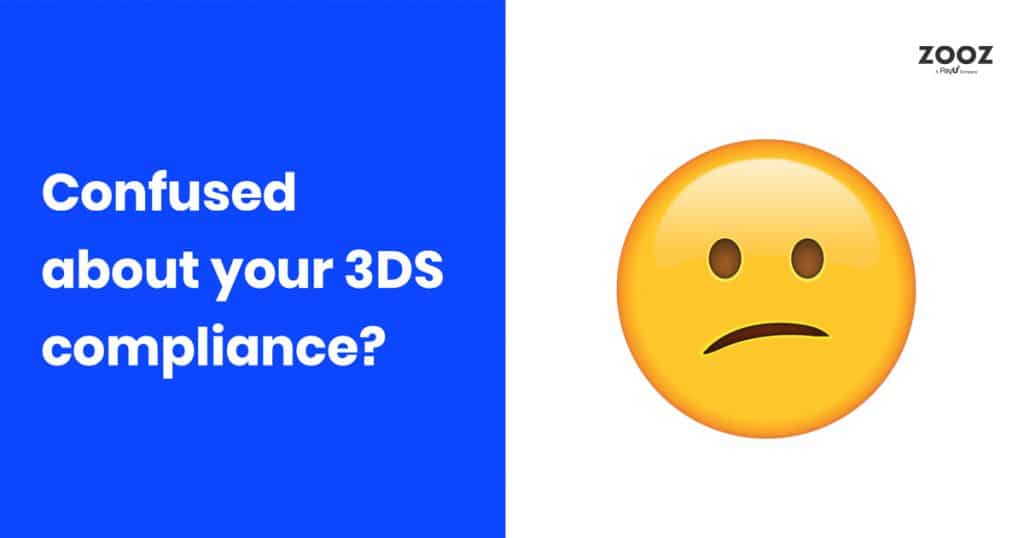eWallets: overview and integration in your offering
The use of eWallets has grown significantly in recent years, in accordance with the expansion and growth of eCommerce, and both as a local and global payment method. eCommerce is not showing any signs of slowing down, and its spread is projected to continue to grow and expand in years to come, with an estimated leap from 36% to 47% by 2020*
Being a relatively new payment method, the adoption of eWallets in different markets and industries varies greatly – due to regulations, infrastructure, and level of consumer readiness. Apple Pay and Android Pay are currently targeting markets like Europe, Asia Pacific, and the U.S., while other eWallets like Samsung Pay are turning their attention elsewhere. In China, Alipay and WeChat have become so dominant in that merchants are currently facing a reality in which, if they wish to enter those markets, they are bound to offer these payment methods to their potential customers (according to China ranked at number one with 65% of online payments made using some form of an eWallet).
Enjoying our content? Make sure to sign up for our newsletter
What are eWallets?
eWallets, or digital wallets, are a type of pre-paid account that allows users to store money (e.g. cryptocurrency, credit cards, etc.) and easily access it for any future transaction.
In order to use an eWallet, a registration process is usually required of users, and they may also need to go through a verification process (what is referred to as a “Know Your Customer” procedure), which may vary between providers. Alternatively – in case users are not verified – they may still be allowed to preform transactions up to a certain amount of money.
An eWallet is based on encryption software, thus replacing the old physical wallet with a safer alternative. It is password protected and stores both the personal data with an added layer of safety. Merchants and clients both benefit from that added layer of security and protection against fraud: Merchants are able to increase their sales and be rest assured with transactions staying protected while customers are more easily nd readily willing to complete transactions, on and off-line. eWallets have greatly evolved beyond just a payment method and nowadays include additional online benefits, such as allowing users to travel card-less in public transportation, send and receive money, accumulate rewards from their favorite merchants and store tickets and “soft copy” purchases.
Should merchants add eWallets to their payment methods?
As previously stated, the use of eWallets is currently growing and expanding, and the adoption rate of these methods varies greatly among different locations. Before merchants choose to make such integration with one or multiple eWallets, it is best for them to determine first who their target audience is, and understand their business goals and growth rate: Are they targeting the Asian market? The South American market? Are they currently experiencing hyper-growth and need to cater to more customers? And most importantly – will such integration allow them to increase their bottom-line? If a merchant concludes that an addition of eWallets is necessary to their business growth, then yes, they should definitely consider to include them.
eWallets and their geographical spread
Although eWallets may not necessarily be limited to specific locations (exclusions apply), they are very much “location-based” in the sense that their spread and frequency of use differ from one geographical location to another. What is prevalent in China might not be readily-available or popular in different locations, so a merchant’s decision of what method to add to their offering next needs to reflect the needs of their target market. Here are the most prominent eWallets in various regions around the worlds, as well as some regional highlights:
APAC
- Australia: When it comes to eWallets, the usage in the Australian market was reported to be18% in 2017 – PayPal and Visa Checkout being the most prominent alternative payment methods.
- China: dominating 65% of the market in terms of payment, eWallets such as Ali Pay and WeChat pay are the most prevalent payment method for both online and point-of-sale purchases.
- India: the use of eWallets is rapidly growing in accordance with the expansion of smartphone use. Standing currently at 26% for online purchases, merchants should consider adding alternative payment methods such as the Paytm if the Indian market is a target audience. *
Europe
- The European market uses eWallets for ~20% of online purchases. The use of these methods for points-of-sale purchases is still minimal (2%). Preference and usage vary among different parts of Europe – While in the UK you can see the dominance of methods such as Paypal and VISAcheckout, in Northern European countries like Sweden, Norway and Denmark, the usage of payment alternatives like Klarna and Vipps take a larger share of the market. Klarna is also gaining in popularity in Germany. The French use PayPal and Masterpass as their preferred alternative payment method while Italians use Paypal and Postepay.
- As a rule of thumb, PayPal is still the safest bet to target the majority of the European market. *
North America
- In Canada, credit card usage is still dominating in the market (64% percent), while the usage of eWallets stands at 16%.
- In the US, eWallets account to 20% of online payments, following the footsteps of the more established credit cards (32%).
- Paypal is popular both in the US and Canada. VISAcheckout is another popular method in the US while Canadians favor Interac Online alongside Paypal. *
Latin America
- Credit card usage currently dominates in the Latin American market, standing at a whopping 45%, while eWallets are at the 15% mark. This trend is projected to shift though, and by 2020 eWallet usage is estimates to get to 18% while credit card usage will drop to 36%.
- Paypal and Mercado Pago are the most popular alternative payment methods in the Latin American markets. *
Africa
- The African continent shows different usage of eWallets in different parts of the continent. Whereas the numbers in South Africa are similar to their European counterparts (25% credit card usage and 17% eWallet usage, Paypal and Masterpass being the most popular); Other countries e.g. Nigeria, are still dominated by cash usage (24%) while eWallet usage stands at 10%. *
* All information is based on the Worldpay’s 2018 Global Payments Report
What’s your next step?
eWallets are growing in popularity and have become an important way to offer global customers the best payment experience for their local needs. According to the Paypers Method Report 2017, the adoption of e-wallets varies greatly among locations – while in the US and Europe the adoption is slower than expected (but is expected to rise in popularity within the next 3 years), in India, eWallet-use is growing rapidly in popularity in accordance with the growth of smartphone use, while in China, Alipay and WeChat Pay already based their status as the most popular forms of payment both for online and offline purchases.
For merchants taking the leap into hypergrowth, an integration with a variety of payment methods becomes a crucial catalyst for success, and integration often times becomes a prerequisite for successful growth and increased income. That fact becomes even more crucial when trying to break into foreign markets which use different payment methods, as it affects the customer experience you offer as a merchant, and inevitably – your potential revenue.
At ZOOZ, we allow merchants to connect to as many payment providers as they desire (via a single API). In order to provide the easiest and most versatile connectivity for our customers, we are constantly working to add more payment methods (eWallets included) to give merchants the flexibility and freedom to cater to customers located in different locations around the world.





